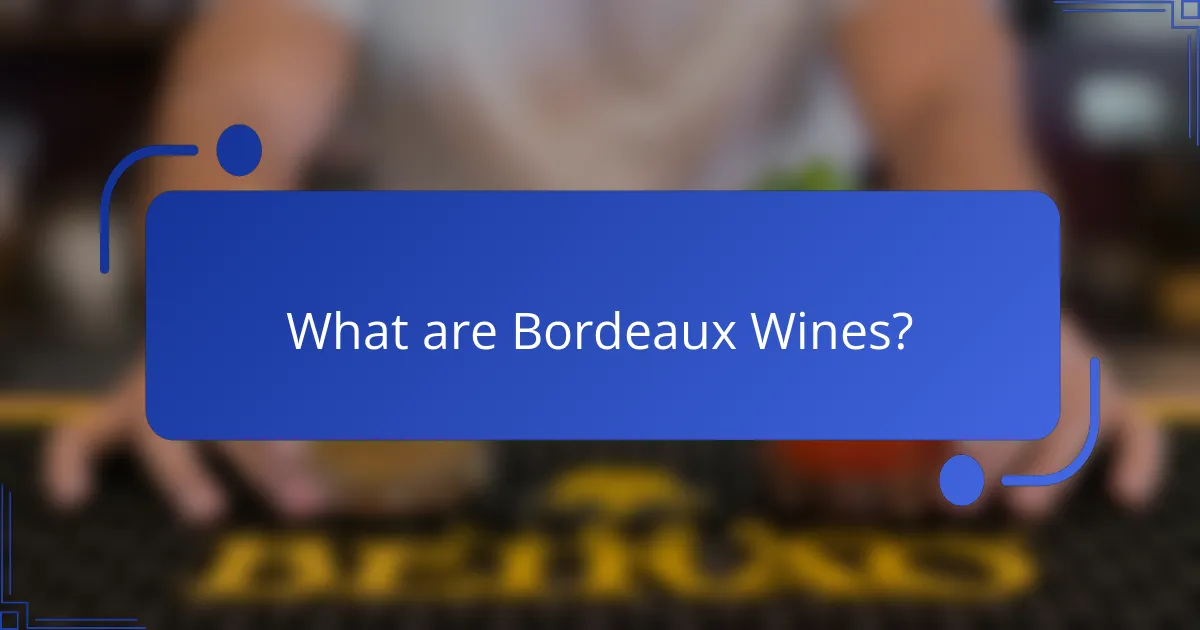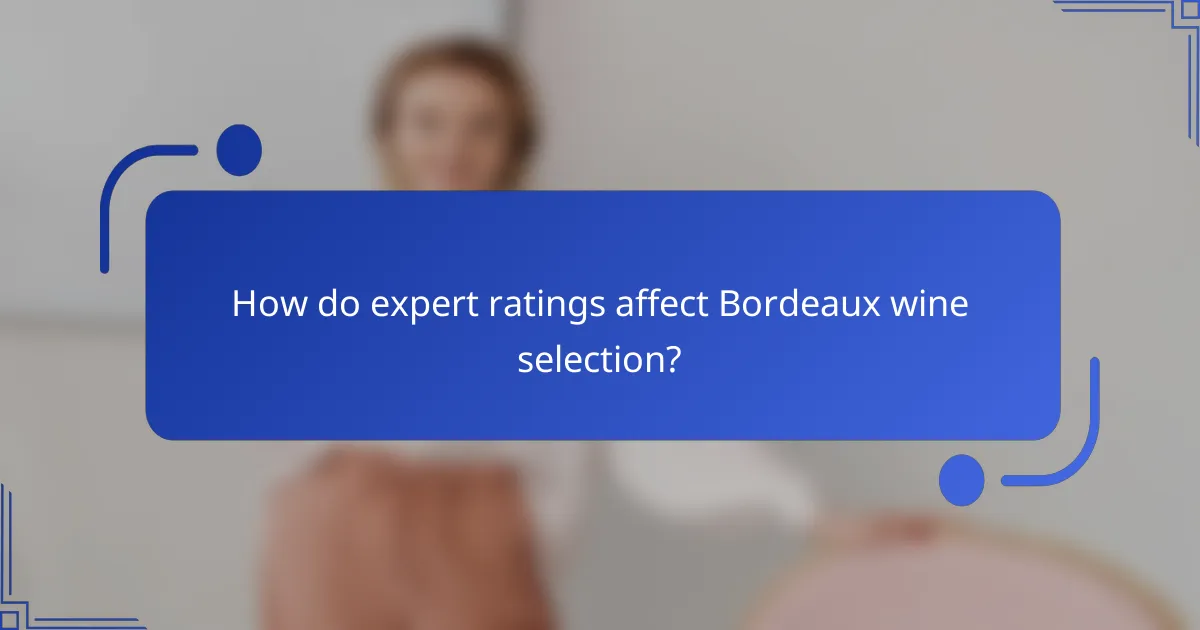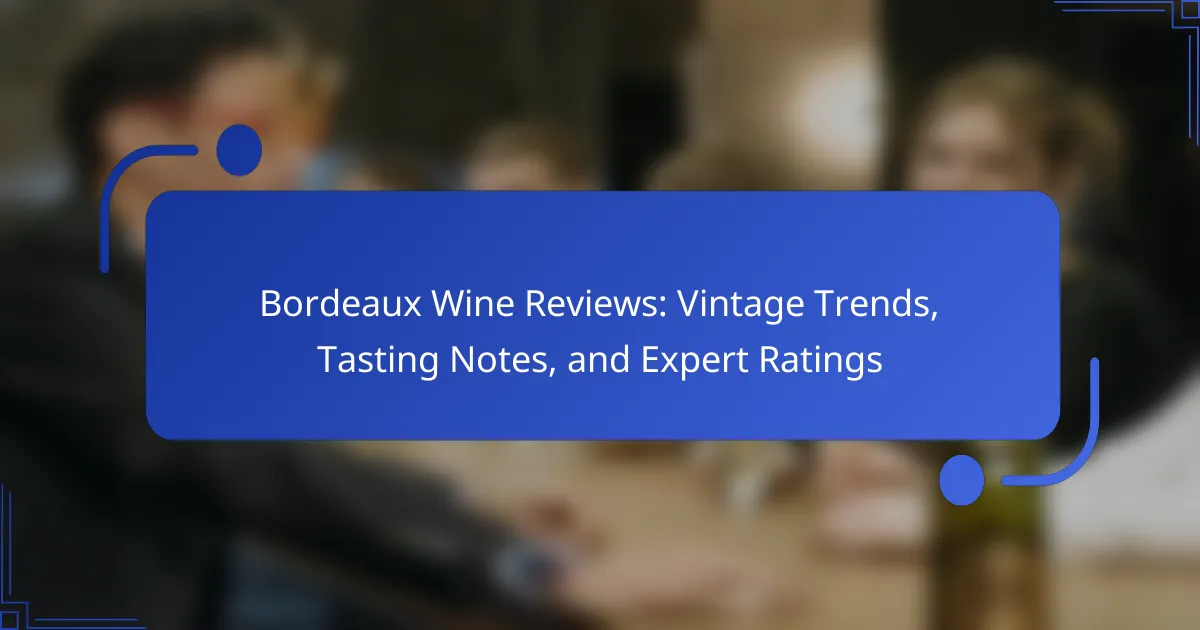
What are Bordeaux Wines?
Bordeaux wines are red, white, and rosé wines produced in the Bordeaux region of France. This region is renowned for its diverse grape varieties, including Merlot, Cabernet Sauvignon, and Cabernet Franc. Bordeaux wines are typically characterized by their complexity and aging potential. The Bordeaux region is divided into several sub-regions, each with distinct terroirs. Notable sub-regions include Médoc, Saint-Émilion, and Pomerol. Bordeaux wines are often blended, which enhances their flavor profiles. The region’s wine production dates back to Roman times, establishing a long history of viticulture. Bordeaux wines are highly regarded globally, often featured in prestigious wine competitions and rankings.
How is Bordeaux Wine classified?
Bordeaux wine is classified primarily into several categories based on quality and origin. The main classification includes the Bordeaux AOC, which signifies wines from the Bordeaux region. Within this, there are sub-classifications such as the Médoc classification, which ranks wines from the Médoc area, including the prestigious 1855 classification. This classification divides wines into five growths, or “crus,” based on reputation and quality. Additionally, there are classifications for specific appellations like Saint-Émilion, which has its own ranking system that includes Premier Grand Cru Classé and Grand Cru Classé. These classifications are based on criteria such as vineyard location, historical reputation, and tasting evaluations. The classification systems help consumers identify quality and value in Bordeaux wines.
What are the main regions within Bordeaux?
The main regions within Bordeaux are the Médoc, Saint-Émilion, Pomerol, Graves, Sauternes, and Entre-Deux-Mers. The Médoc is known for its Cabernet Sauvignon-based wines. Saint-Émilion is famous for its Merlot-dominant blends. Pomerol produces rich, velvety wines primarily from Merlot. Graves is recognized for both red and white wines, with a focus on Cabernet Sauvignon and Sauvignon Blanc. Sauternes specializes in sweet wines made from botrytized grapes. Entre-Deux-Mers is known for its dry white wines, primarily from Sauvignon Blanc and Sémillon grapes. Each region contributes distinct characteristics to Bordeaux wines, reflecting the terroir and grape varieties used.
What are the characteristics of Bordeaux wine classifications?
Bordeaux wine classifications are primarily characterized by their hierarchical structure. This structure includes several levels, such as Grand Cru Classé, Cru Bourgeois, and AOC. Each classification reflects the quality and reputation of the wineries. Grand Cru Classé represents the highest quality, established in 1855. It includes 61 châteaux, recognized for their exceptional terroir and winemaking. Cru Bourgeois is a classification for quality wines from lesser-known estates, introduced in 1932. AOC, or Appellation d’Origine Contrôlée, ensures adherence to specific regional standards. Bordeaux classifications also consider grape varieties, aging potential, and vineyard practices. These classifications guide consumers in selecting wines and indicate the expected quality.
Why are vintage trends important in Bordeaux wine?
Vintage trends are important in Bordeaux wine because they significantly influence quality and market value. Each vintage reflects the climatic conditions of that year, affecting grape ripeness and flavor profiles. For instance, the 2005 vintage is renowned for its exceptional quality due to ideal weather conditions. In contrast, the 2013 vintage faced challenges with excessive rain, leading to lower quality wines. Collectors and investors often prioritize specific vintages based on historical performance. This trend affects pricing; sought-after vintages can command higher prices at auctions. Additionally, understanding vintage trends helps consumers make informed purchasing decisions. Overall, vintage trends provide insights into the wine’s potential longevity and enjoyment.
How do weather conditions influence Bordeaux wine vintages?
Weather conditions significantly influence Bordeaux wine vintages. Temperature, rainfall, and sunlight play crucial roles in grape development. Warm temperatures can lead to earlier harvests and higher sugar levels in grapes. Conversely, excessive rain can dilute flavors and increase disease risk. Ideal conditions promote balanced acidity and tannins. Historical data shows that notable vintages often coincide with favorable weather patterns. For example, the exceptional 2005 vintage experienced a warm, dry summer. Such conditions resulted in ripe, concentrated grapes, leading to high-quality wines. Thus, weather directly impacts the characteristics and quality of Bordeaux wines each vintage.
What historical events have impacted Bordeaux wine vintages?
Bordeaux wine vintages have been significantly impacted by several historical events. The 1855 Bordeaux Classification established quality rankings that influenced pricing and reputation. The phylloxera epidemic in the late 19th century devastated vineyards, leading to replanting with American rootstocks. The two World Wars caused disruptions in production and trade, affecting availability. The 1970s oil crisis led to economic challenges for producers, impacting investment in vineyards. Additionally, climate changes and events like the 2017 frost have caused fluctuations in harvest yields. Each of these events has shaped the characteristics and market perception of Bordeaux wines over time.
What should you know about tasting notes for Bordeaux wines?
Tasting notes for Bordeaux wines highlight their complex flavors and aromas. Bordeaux wines typically exhibit a range of tasting notes, including blackcurrant, plum, and cherry. These notes are often complemented by earthy undertones and hints of tobacco or leather. The wines can also present floral aromas, such as violet or rose. Tasting notes vary by grape variety; Merlot often shows softer fruit notes, while Cabernet Sauvignon delivers more structure and tannins. The aging process in oak barrels adds vanilla and spice characteristics. Understanding these notes enhances the appreciation of Bordeaux wines. Tasting notes are essential for wine enthusiasts and collectors when evaluating quality and pairing with food.
What are the common flavor profiles found in Bordeaux wines?
Bordeaux wines commonly exhibit flavors of dark fruits, such as blackcurrant and plum. These wines often have earthy notes, including tobacco and leather. Oak aging contributes vanilla and spice characteristics. Additionally, herbal nuances like cedar and graphite are frequently detected. Bordeaux blends typically feature a balance of acidity and tannins. The flavor profile can vary depending on the grape variety used. For example, Merlot tends to be softer and fruitier, while Cabernet Sauvignon is more structured and tannic. These attributes are consistent across various vintages and regions within Bordeaux.
How can you identify the aromas in Bordeaux wines?
To identify the aromas in Bordeaux wines, start by observing the wine’s color and clarity. Swirl the wine in the glass to release its aromatic compounds. Bring the glass to your nose and take a gentle sniff. Focus on the primary aromas, which may include fruits, flowers, and spices. Common fruit aromas in Bordeaux wines include blackcurrant, plum, and cherry. Secondary aromas may arise from the fermentation process, such as vanilla or toast. Tertiary aromas develop with aging, often featuring leather, tobacco, or earthy notes. Practice and experience will enhance your ability to recognize these aromas.

How do expert ratings affect Bordeaux wine selection?
Expert ratings significantly influence Bordeaux wine selection. Consumers often rely on ratings from recognized critics to guide their purchases. High ratings can enhance a wine’s perceived value and desirability. For example, a wine rated 95 points or higher may sell for significantly more than one rated below 90 points. This trend is evident in auction results and retail prices. Additionally, expert ratings can shape consumer perceptions and expectations about a wine’s quality. Many buyers consider these ratings when selecting wines for investment or personal consumption. Thus, expert ratings play a crucial role in the Bordeaux wine market.
What criteria do experts use to rate Bordeaux wines?
Experts use several criteria to rate Bordeaux wines. These criteria include appearance, aroma, taste, and finish.
Appearance assesses the wine’s clarity and color intensity. Aroma evaluation focuses on the complexity and balance of scents. Taste analysis examines flavor profile, structure, and mouthfeel. Finish considers the length and quality of aftertaste.
Experts often use a point system for scoring. This system typically ranges from 0 to 100 points. A score above 90 is considered outstanding.
Additionally, the reputation of the vineyard and vintage year influences ratings. Historical performance and expert consensus also play significant roles in the evaluation process.
How does the rating scale work for Bordeaux wines?
The rating scale for Bordeaux wines typically ranges from 50 to 100 points. This scale evaluates the wine’s quality based on various criteria. Factors include aroma, flavor, balance, and finish. Wines scoring above 90 are considered exceptional. A score of 80 to 89 indicates good quality. Ratings are often provided by wine critics and publications. The Bordeaux Wine Official Classification of 1855 is a historical reference. It classifies wines into five growths, influencing their perceived value and quality. Ratings can impact market prices significantly.
What are some renowned wine critics and their influence?
Renowned wine critics include Robert Parker, James Suckling, and Jancis Robinson. Robert Parker is known for his 100-point rating scale. His reviews have significantly influenced wine prices and consumer choices. James Suckling, a former Wine Spectator editor, emphasizes tasting experiences. His ratings also impact market trends and collector interest. Jancis Robinson is a respected authority in wine education. She promotes understanding and appreciation of wine through her writings. These critics shape perceptions and market dynamics in the wine industry. Their influence can lead to increased demand for specific vintages.
What are the implications of expert ratings for consumers?
Expert ratings significantly influence consumer decisions regarding Bordeaux wines. These ratings provide a trusted assessment of wine quality. Consumers often rely on expert evaluations to guide their purchases. High ratings can increase a wine’s perceived value and desirability. Conversely, low ratings may deter consumers from selecting a particular wine. Research shows that consumers are more likely to purchase wines with higher expert scores. This reliance on ratings can shape market trends and pricing strategies. Ultimately, expert ratings serve as a critical tool for consumers navigating the Bordeaux wine market.
How can ratings guide your purchasing decisions?
Ratings can guide your purchasing decisions by providing a standardized assessment of product quality. They reflect expert opinions and consumer experiences regarding Bordeaux wines. High ratings often indicate superior taste, aging potential, and overall value. For instance, a wine rated above 90 points is typically considered excellent. Ratings can also highlight trends in specific vintages, helping consumers identify the best years for Bordeaux. Additionally, they simplify comparison shopping among various brands and price points. Research shows that 80% of consumers consider ratings before making a purchase. Thus, leveraging ratings can enhance informed decision-making in wine selection.
What should you consider beyond ratings when choosing Bordeaux wines?
When choosing Bordeaux wines, consider factors such as terroir, vintage, and producer reputation. Terroir refers to the unique environmental conditions affecting grape growth. Bordeaux’s diverse terroirs influence the flavor profiles of wines. Vintage indicates the year grapes were harvested, impacting quality and style. Some years yield exceptional wines due to favorable weather conditions. Producer reputation is crucial; established wineries often maintain consistent quality. Research shows that wines from renowned producers tend to perform better over time. Additionally, personal taste preferences should guide your selection, as individual palates vary widely.

What are the best practices for enjoying Bordeaux wines?
To enjoy Bordeaux wines, serve them at the right temperature. Red Bordeaux is best at 60-65°F, while white Bordeaux should be served chilled at 45-50°F. Use appropriate glassware to enhance the tasting experience. Bordeaux wines benefit from a large bowl to allow for aeration. Decanting is recommended for younger red Bordeaux to soften tannins. Pairing Bordeaux with food enhances its flavors. Red Bordeaux complements red meats and rich dishes. White Bordeaux pairs well with seafood and light appetizers. Finally, savor the wine by taking small sips to appreciate its complexity.
How should Bordeaux wines be stored for optimal quality?
Bordeaux wines should be stored in a cool, dark, and humid environment for optimal quality. Ideal storage temperature ranges between 50°F to 59°F (10°C to 15°C). Consistent temperature is crucial; fluctuations can damage the wine. Humidity levels should be around 70% to prevent corks from drying out. Bordeaux bottles should be stored horizontally to keep the cork moist. Light exposure can degrade the wine, so avoid direct sunlight. Vibrations can disturb sediment, so store wines in a stable location. These practices help preserve the wine’s flavor and aging potential.
What is the ideal serving temperature for Bordeaux wines?
The ideal serving temperature for Bordeaux wines is between 60°F to 65°F (15°C to 18°C). This range allows the wine’s flavors and aromas to fully develop. Serving Bordeaux at this temperature enhances the tasting experience. Red Bordeaux wines, in particular, benefit from slightly warmer temperatures to showcase their complexity. Proper serving temperature is crucial for optimal enjoyment. Temperature impacts the perception of acidity and tannins in the wine. Therefore, serving Bordeaux wines within this range is recommended by wine experts.
How can you enhance your tasting experience with food pairings?
Enhancing your tasting experience with food pairings involves selecting complementary flavors. Pairing Bordeaux wines with appropriate foods elevates both the wine and the meal. For example, rich red Bordeaux wines often pair well with red meats. This combination highlights the wine’s tannins and enhances the meal’s flavor profile. White Bordeaux wines can complement seafood and poultry, balancing acidity with the dish’s richness. Studies show that food and wine interactions can significantly influence taste perception. Proper pairings can enhance aromas and flavors, creating a more enjoyable dining experience.
What tips can help you appreciate Bordeaux wines more fully?
To appreciate Bordeaux wines more fully, focus on understanding their unique characteristics. Bordeaux wines are typically blends of grape varieties like Cabernet Sauvignon, Merlot, and Cabernet Franc. Familiarize yourself with the specific regions within Bordeaux, such as Médoc and Saint-Émilion. Tasting wines from different vintages can reveal how aging affects flavor profiles. Use proper glassware to enhance aroma and taste. Take note of the wine’s color, aroma, and mouthfeel during tasting. Pair Bordeaux wines with complementary foods, like red meats or rich cheeses. Participating in guided tastings can provide expert insights and deepen your appreciation.
How can you develop your palate for Bordeaux wines?
To develop your palate for Bordeaux wines, start by tasting a variety of Bordeaux styles. Focus on different regions within Bordeaux, such as Médoc, Saint-Émilion, and Pomerol. Each region produces distinct flavor profiles that enhance your understanding. Attend wine tastings and events to experience multiple vintages and blends. Take notes on aromas, flavors, and textures to track your preferences. Pair Bordeaux wines with food to explore how flavors interact. Read wine reviews and expert ratings to gain insights into specific bottles. Engaging with knowledgeable sommeliers can also provide valuable guidance. Regular practice will refine your palate over time.
What resources are available for further learning about Bordeaux wines?
Books on Bordeaux wines include “Bordeaux: A Comprehensive Guide” by Stephen Brook. Online courses are available through platforms like MasterClass and Wine Folly. Wine tasting events often feature Bordeaux wines and provide educational insights. Wine clubs specializing in Bordeaux offer curated selections and expert discussions. Websites like Wine Spectator and Decanter provide articles and reviews on Bordeaux vintages. The Bordeaux Wine Council (CIVB) offers resources and information about the region and its wines. Local wine shops may host classes focusing on Bordeaux wines.
Bordeaux wines are a prominent category of red, white, and rosé wines produced in the Bordeaux region of France, known for its diverse grape varieties and complex flavor profiles. The article covers Bordeaux wine classifications, including the Bordeaux AOC and notable sub-regions like Médoc and Saint-Émilion, as well as the impact of vintage trends and weather conditions on wine quality. Additionally, it discusses expert ratings, their influence on consumer choices, and best practices for tasting and storing Bordeaux wines. Key tasting notes and flavor profiles are also outlined to enhance appreciation and selection.
